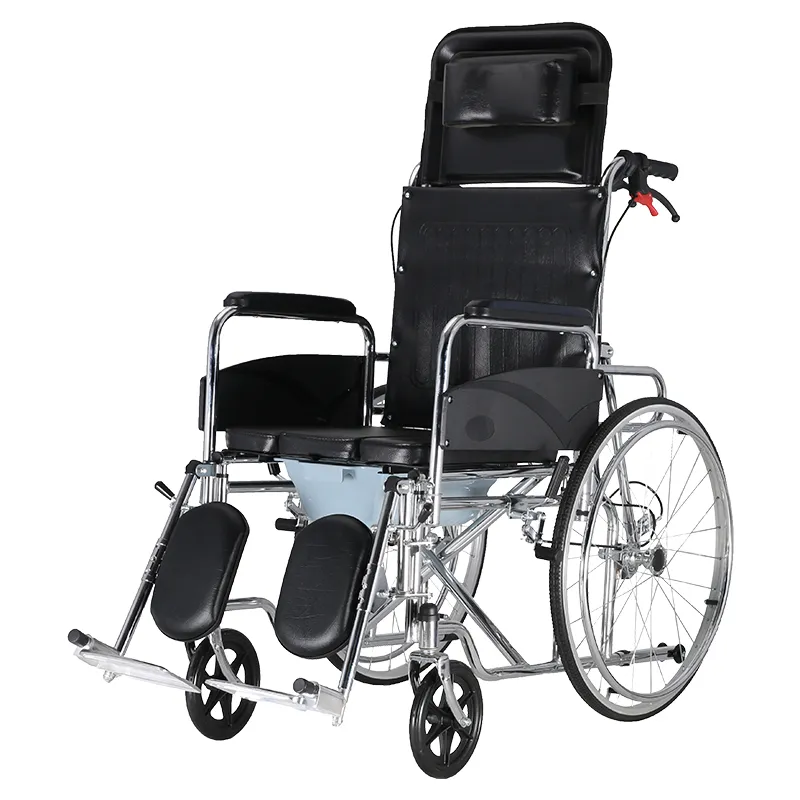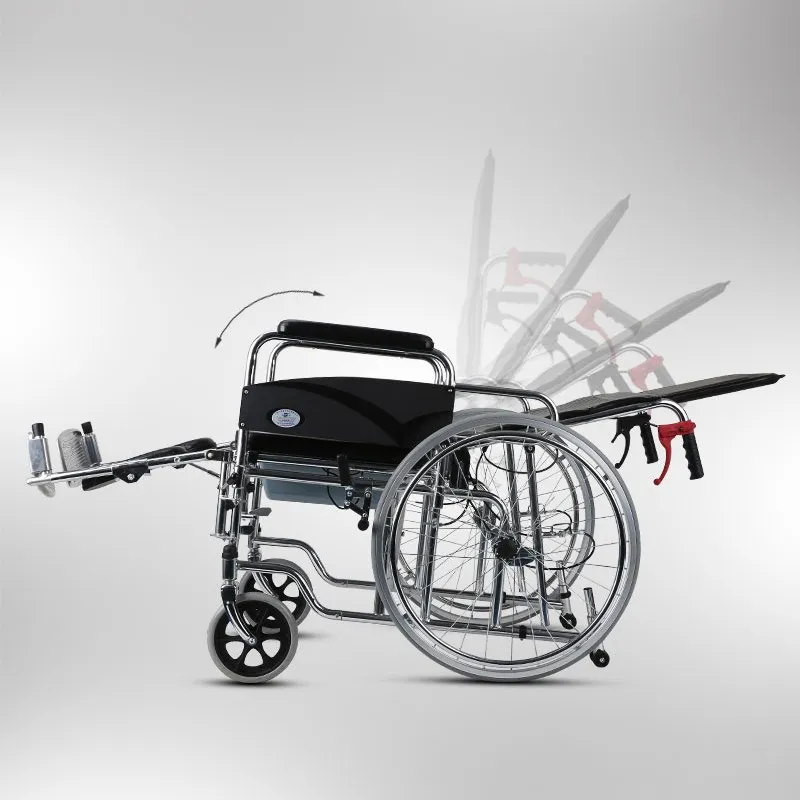What is a Toilet Wheelchair?
A commode wheelchair is a nursing assistive device that combines the functions of a wheelchair and a commode. It allows the user to move like a regular wheelchair, while also providing a commode or bedpan opening under the seat to facilitate toileting for those with mobility impairments.
Unlike traditional fixed toilet chairs or portable toilets, commode wheelchairs emphasize the integration of mobility and toileting functionality: the user can sit in the commode wheelchair at the bedside or in the room, and caregivers or the user themselves can push the wheelchair to the required location (such as the toilet, shower, or near the bed), where they can relieve themselves, thus reducing the number of transfers and the burden of care.
Key differences between commode wheelchairs and regular wheelchairs include:
• An opening or bedpan in the seat for collecting waste;
• A waterproof and easy-to-clean design for convenient hygiene;
• Typically equipped with brakes, armrests, and removable parts for securing and cleaning;
• Some models feature height-adjustable or tilting functions for easy transfer and caregiving.
Understanding the definition of a commode wheel chair allows family members and caregivers to make more practical choices in care planning.

What types of toilet wheelchairs are there?
Toilet wheelchairs are not a single style. Common types in the market and medical institutions include:
1. Manual Toilet Wheelchair
Primarily propelled manually, these have a simple structure and lower cost, suitable for users who need short-distance indoor movement and nursing assistance.
2. Electric Toilet Wheelchair
Equipped with a motor and joystick, these are suitable for users with limited physical strength or those who travel independently, especially on longer distances or uneven surfaces (note the waterproofing and battery safety of the electric system).
3. Foldable or Portable Toilet Wheelchair
Easy to store and move, suitable for temporary use at home or while traveling, but their stability and load-bearing capacity may be weaker than fixed models.
4. Heavy-Duty/Ruggedized Toilet Wheelchair
Designed for heavier users or those requiring additional support, these have a sturdy frame and high load-bearing capacity, but are larger and heavier.
5. Multifunctional Toilet Wheelchair with Transfer and Tilt Functions
These wheelchairs allow for tilting or sitting adjustments, facilitating patient transfers and reducing the risk of pressure sores. However, they are structurally complex and expensive.
Different types are suitable for different scenarios. For example, frequent bedside toileting, bathrooms that cannot be easily modified for accessibility, and temporary replacements during rehabilitation may require different models of commode wheel chairs. The choice should consider the environment, the user's abilities, and the nursing process.

What are the significant advantages of toilet wheelchairs?
Advantages of toilet wheelchairs:
1. Reduced Risk of Handling and Transfer
2. Enhanced Privacy and Dignity During Toileting
3. Saves Caregiver Time and Manpower
4. Versatile Application, Improved Quality of Life
5. Easy to Clean and Maintain (Some Models)
6. Configurable Assistive Functions
1). Reduced Risk of Handling and Transfer
Using a toilet wheelchair reduces the number of times patients need to be lifted from the bed or transferred from the wheelchair to the commode. Frequent handling is a major cause of falls and back injuries for caregivers during nursing care. Toilet wheelchairs reduce unnecessary transfers between the bedside, the bed, and the bathroom, thus reducing the risk of accidents.
2). Enhanced Privacy and Dignity During Toileting
For many people with limited mobility, relying on others to transfer them to the bathroom is inconvenient and can be embarrassing. Toilet wheelchairs allow toileting to be done close to the bed or in a private space, helping to maintain the user's privacy and dignity.
3). Saves Caregiver Time and Manpower
Caregivers using commode wheel chairs can perform toilet care more efficiently, reducing the need for lifting, securing, and safety checks, thus saving manpower and allowing them to focus their energy on other care tasks.
4). Versatile Application, Improved Quality of Life
Toilet wheelchairs are suitable for use at home, in nursing homes, hospitals, and temporary settings (such as rehabilitation centers or while traveling). They are a flexible alternative, especially when residential bathrooms cannot be fully accessible.
5). Easy to Clean and Maintain (Some Models)
Many toilet wheelchairs feature removable potty bowls and water-resistant materials, facilitating cleaning and disinfection and reducing cross-infection and odor issues (provided they are used correctly and cleaned promptly).
6). Configurable Assistive Functions
High-end models may be equipped with removable armrests, adjustable backrests, folding footrests, and sealed potty lids, increasing convenience and comfort.
In summary, commode wheel chairs offer tangible advantages in terms of safety, convenience, and care efficiency.

What are the disadvantages of toilet wheelchairs?
Disadvantages of toilet wheelchairs:
1. High Requirements for Cleaning and Hygiene Management
2. Risk of Pressure Ulcers
3. Stability and Tilting Risk
4. Privacy and Odor Management Issues
5. Cost and Maintenance
6. Weight and Size Limitations
7. User Capacity Limitations
1). High Requirements for Cleaning and Hygiene Management
Toilet wheelchairs directly handle excrement. If cleaning is not timely or disinfection is inadequate, bacteria can easily grow, odors can develop, and the risk of infection increases. Caregivers need to master correct cleaning procedures, disinfectant usage methods, and waste disposal protocols.
2). Risk of Pressure Ulcers
Sitting in a commode wheel chair for extended periods (especially when the user cannot move actively) can increase localized pressure. Poorly designed seat cushions or commodes, or failure to regularly change position, can easily lead to pressure ulcers. Appropriate pressure-resistant seat cushions and regular position adjustment strategies are necessary.
3). Stability and Tilting Risk
Some lightweight or folding commode wheel chairs lack stability when carrying or pushing, and may slide or tip over on slopes or uneven surfaces. When choosing a wheelchair, pay attention to frame width, wheelbase, and anti-tipping devices.
4). Privacy and Odor Management Issues
Without proper ventilation or sealing design, odors from the commode can affect the living environment. Odor control is especially important when using it at night or in the bedroom.
5). Cost and Maintenance
High-end or multi-functional commode wheel chairs are more expensive; electric models also involve battery and motor maintenance, and long-term operating costs cannot be ignored. Availability of repairs and parts replacements must be considered.
6). Weight and Size Limitations
Each commode wheel chair has weight-bearing and seat width limitations. Larger or extremely heavy users should choose heavy-duty or reinforced models; otherwise, there are safety hazards.
7). User Capacity Limitations
If the user has cognitive decline or behavioral instability (such as epilepsy, inability to cooperate, etc.), full manual assistance is still required when using a toilet wheelchair to prevent falls or accidental contact with the toilet bowl.
In short, toilet wheelchairs are neither a panacea nor a tool that requires no supervision. A proper risk assessment and standardized care are essential to maximizing their advantages and minimizing adverse effects.
How to Choose the Right Commode Wheel Chair?
When selecting a commode wheel chair for an individual or institution, a comprehensive evaluation should be conducted based on the following dimensions:
1. User's Physical Condition
• Weight and Body Type: Choose a model with appropriate weight-bearing capacity and seat width;
• Lower and Upper Limb Function: Ability to transfer independently, need for handrail support or assistance to stand;
• Cognition and Cooperation Level: Affects whether independent use or full-time care is required.
2. Usage Environment
• Home or Institutional Space: Are doorways, corridors, and turning radius sufficient?
• Outdoor Mobility Required: If outdoor use is required, choose a model with larger wheel diameters and shock absorption structures;
• Bathroom Conversion Possibility: If an accessible bathroom can be converted, a regular wheelchair combined with an accessible commode may replace the commode wheel chair.
3. Functional and Configuration Requirements
• Height adjustment required: Height adjustment facilitates movement when used at the bedside;
• Removable or flip-up armrests: Facilitates lateral transfer or nursing procedures;
• Seat and lid design for the bedpan: Helps control odor;
• Electric drive required: Consider an electric model if the user is expected to control and move independently.
4. Materials and Load Capacity
• Frame material (aluminum alloy, carbon steel, etc.) affects strength and weight;
• Seat cushion material affects comfort and cleanliness;
• Load capacity rating should have a safety margin (10–20% of the user's weight).
5. Cleaning, Maintenance, and After-Sales Service
• Is the bedpan easy to disassemble and clean?
• Are replacement parts and after-sales service provided?
• Battery life and replacement cost for electric models.
After conducting these assessments, comparing different brands and models based on budget and usage frequency will often allow you to choose a commode wheel chair that balances safety, comfort, and economy.

Common Misconceptions and Corrections about Toilet Wheelchairs
Misconception 1: Toilet wheelchairs are only suitable for those who are completely bedridden.
Correction: Toilet wheelchairs are also suitable for some users who can sit up but cannot walk or move safely. Their core function is to reduce the number of transfers and provide a convenient toilet solution.
Misconception 2: All toilet wheelchairs are easy to clean.
Correction: Not all models are easy to disassemble and clean. When purchasing, check the disassembly method of the toilet bowl, the seat material, and whether it supports high-temperature sterilization.
Misconception 3: The higher the price, the better.
Correction: Higher price does not necessarily mean more suitable. The cost-effectiveness should be judged based on actual usage needs (such as whether electric operation is required, whether heavy-duty load-bearing is required).
Misconception 4: The more complex the electric model, the more convenient it is.
Correction: Electric models increase independence, but also introduce battery maintenance and waterproofing issues. For users who only use the wheelchair for short distances indoors, manual models are simpler and more reliable.
Identifying these misconceptions can help decision-makers avoid blindly purchasing or using unsuitable configurations.
Can a toilet wheelchair be placed directly above the toilet seat?
Some narrow or specially designed commode wheel chairs can be used with a commode (called an "over-toilet commode"), but the size and securing method must be confirmed to prevent sliding or tipping.
What is the safest way to dispose of commode waste?
After use, seal the commode lid, empty it in an appropriate facility (such as a covered trash can or waste disposal room), and immediately rinse with warm water. Then disinfect with a hospital-grade disinfectant and let it air dry.
Does prolonged bedside use of a toilet wheelchair increase the risk of pressure sores?
Prolonged fixed sitting does increase the risk of pressure sores. Use a pressure-relieving seat cushion and adjust the position regularly. If necessary, have a nursing professional assess your skin condition and cushion type.
How long does a commode wheel chair typically last?
It depends on the materials, frequency of use, and maintenance. Generally, manual models can last several years with good maintenance; electric models require attention to battery life (usually 2–5 years) and motor maintenance.
Is a toilet wheelchair suitable for you or your family?
Toilet wheelchairs are highly practical assistive devices in nursing and home care. They can improve care efficiency, reduce transport risks, and enhance privacy and dignity during toileting. However, they also present challenges such as hygiene management, pressure sore risk, and maintenance costs. The decision to choose a commode wheel chair should be based on the following considerations:
• Does the user have frequent and difficult transport and toileting needs?
• Is the space and environment of the home or institution suitable for placement and cleaning?
• Do caregivers have the necessary cleaning and operating procedures?
• Can a model that matches the user's weight, height, and cognitive abilities be selected?
When these conditions are carefully assessed, commode wheel chairs can often become an effective tool for improving quality of life and care safety. Conversely, neglecting cleaning, maintenance, and positioning management can lead to adverse consequences.


